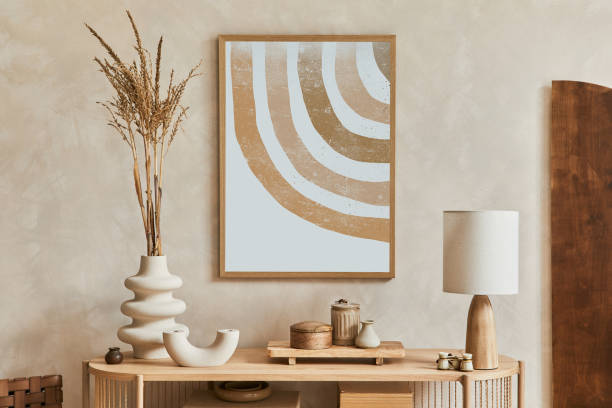Embracing Wabi-Sabi: The Art of Imperfect Beauty in Home Design
In a world obsessed with perfection, a revolutionary design philosophy is quietly making waves in the home decor scene. Wabi-sabi, an ancient Japanese aesthetic principle, celebrates the beauty of imperfection, impermanence, and incompleteness. This article delves into the captivating world of wabi-sabi design, exploring how it's reshaping our perception of beauty and transforming living spaces into havens of tranquility and authenticity.

The Origins of Wabi-Sabi
Wabi-sabi finds its roots in 15th century Japanese tea ceremonies, where simplicity and rustic elegance were highly prized. The term wabi originally referred to the loneliness of living in nature, while sabi denoted the passage of time or withered beauty. Over centuries, these concepts merged to form a worldview that celebrates the imperfect, impermanent, and incomplete aspects of life.
In the context of home design, wabi-sabi translates into an appreciation for natural materials, organic forms, and the subtle patina that develops as objects age. It’s a stark contrast to the sleek, mass-produced aesthetic that has dominated modern interiors for decades.
Key Principles of Wabi-Sabi Design
At its core, wabi-sabi design embraces several fundamental principles:
- Simplicity: Spaces are uncluttered and focused on essential elements.
- Authenticity: Natural materials and handcrafted items are favored over synthetic or mass-produced goods.
- Imperfection: Flaws, asymmetry, and irregularities are celebrated rather than hidden.
- Transience: The ephemeral nature of life is acknowledged through objects that age gracefully.
- Connection to nature: Organic forms and materials create a sense of harmony with the natural world.
Implementing Wabi-Sabi in Your Home
Incorporating wabi-sabi principles into your living space doesn’t require a complete overhaul. Start by decluttering and focusing on items that truly resonate with you. Embrace natural materials like wood, stone, and linen, allowing their inherent textures and imperfections to shine.
Consider investing in handcrafted pieces, each with its own unique character. A hand-thrown ceramic vase, for example, tells a story through its slight irregularities and adds depth to your decor. Embrace the beauty of wear and tear – a weathered wooden table or a slightly chipped bowl can become cherished focal points in a wabi-sabi inspired space.
The Color Palette of Wabi-Sabi
Wabi-sabi design typically favors a muted, earthy color palette that reflects the natural world. Soft whites, warm grays, and gentle browns form the foundation, while subtle hints of green, blue, or terracotta add depth and interest.
These subdued hues create a sense of calm and allow the textures and forms of objects to take center stage. The overall effect is one of understated elegance and timeless beauty.
Wabi-Sabi and Sustainability
One of the most compelling aspects of wabi-sabi design is its inherent sustainability. By valuing longevity, natural materials, and the beauty of age, this philosophy encourages a more mindful approach to consumption.
Instead of constantly replacing items to keep up with fleeting trends, wabi-sabi inspires us to choose quality pieces that will age gracefully. This not only reduces waste but also creates a home environment that evolves and deepens in character over time.
The Psychological Benefits of Wabi-Sabi Spaces
Beyond its aesthetic appeal, wabi-sabi design offers significant psychological benefits. In a world that often feels chaotic and demanding, a wabi-sabi inspired home provides a sanctuary of calm and authenticity.
By embracing imperfection, we free ourselves from the pressure of maintaining an impossibly flawless environment. This acceptance can lead to reduced stress and a greater sense of contentment with our surroundings and ourselves.
Wabi-Sabi in the Digital Age
As our lives become increasingly digital, the tactile and imperfect nature of wabi-sabi offers a welcome counterbalance. It encourages us to slow down, appreciate the physical world around us, and find beauty in the small, often overlooked details of daily life.
In this context, wabi-sabi isn’t just a design trend – it’s a philosophy that can help us navigate the complexities of modern life with greater grace and mindfulness.
The Future of Wabi-Sabi in Home Design
As more people seek alternatives to the polished perfection of mainstream design, wabi-sabi is poised to play an increasingly significant role in shaping our living spaces. Its emphasis on authenticity, sustainability, and connection to nature aligns perfectly with growing concerns about environmental impact and the desire for more meaningful living environments.
Designers and homeowners alike are finding innovative ways to incorporate wabi-sabi principles into contemporary spaces, creating homes that are both timeless and deeply personal.
Embracing the Beauty of Imperfection
In embracing wabi-sabi, we open ourselves to a new way of seeing and experiencing our homes. It’s an invitation to find beauty in the cracks, celebrate the marks of time, and create spaces that reflect the rich, imperfect tapestry of life.
As we move forward in an increasingly complex world, the simple, grounding principles of wabi-sabi offer a path to creating homes that are not just visually appealing, but deeply nourishing to the soul. By accepting and celebrating imperfection, we can transform our living spaces into authentic reflections of our lives – beautiful, imperfect, and ever-evolving.






